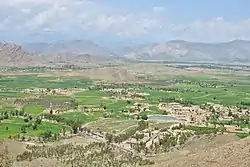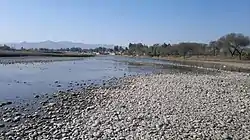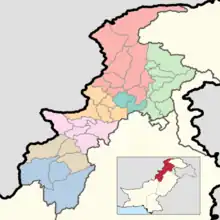Mohmand District
ضلع مہمند مومندو ولسوالۍ Mohmand Agency مہمند ایجنسی مومندو ایجنسئ | |
|---|---|
  | |
.svg.png.webp) Map of Mohmand District | |
| Country | |
| Province | |
| Division | Peshawar |
| Established | 1951 (as an agency of Federally Administered Tribal Areas) |
| Headquarters | Ghalanai |
| Number of Tehsils | 7 |
| Government | |
| • Type | District Administration |
| • Deputy Commissioner | Mr.Arifullah Awan (BPS-18 PAS) |
| • District Police Officer | Muhammad Ayyaz (BPS-18 PSP) |
| • District Health Officer | N/A mm |
| Area | |
| • Total | 2,296 km2 (886 sq mi) |
| Population (2017)[1] | |
| • Total | 474,345 |
| • Density | 210/km2 (540/sq mi) |
| Time zone | UTC+5 (PST) |
| Main language(s) | Pashto[1] |
| Website | mohmand |
Mohmand District (Pashto: مومندو ولسوالۍ, Urdu: ضلع مہمند) is a district in Peshawar Division of Khyber Pakhtunkhwa province in Pakistan. Until 2018, it was an agency of Federally Administered Tribal Areas, with merger of FATA with Khyber Pakhtunkhwa, it became a district. It was created as an agency in 1951. Mohmand is bordered by Bajaur District to the north, Khyber District to the south, Malakand and Charsadda districts to the east and Peshawar district to the southeast.
Mr. Arif Ullah Awan is the current Deputy Commissioner of Mohmand District.[2]
Administration
Mohmand District is currently subdivided into seven Tehsils:[3]
- Ambar Utmankhel Tehsil (Urdu: تحصیل امبر اتمان خیل)(Pashto: امبر اتمان خېل تحصیل)
- Halim Zai Tehsil (Urdu: تحصیل حلیم زئی)(Pashto: حلیمزي تحصیل)
- Pindiali Tehsil (Urdu: تحصیل پنڈیالی)(Pashto: پنډیالي تحصیل)
- Prang Ghar Tehsil (Urdu: تحصیل پڑانگ غار)(Pashto: پړانګ غار تحصیل)
- Safi Tehsil (Urdu: تحصیل صافی)(Pashto: صافي تحصیل)
- Upper Mohmand Tehsil (Urdu: تحصیل مہمند بالا)(Pashto: پورتنۍ مومندو تحصیل)
- Yake Ghund Tehsil (Urdu: تحصیل یکہ غنڈ)(Pashto: یکه غنډ تحصیل)
Provincial Assembly
| Member of Provincial Assembly | Party Affiliation | Constituency | Year |
|---|---|---|---|
| Nisar Mohmand | Awami National Party | PK-64 Mohmand-I | 2019 |
| Malik Abbas Rehman | Balochistan Awami Party | PK-65 Mohmand-II |
Demographics
| Year | Pop. | ±% p.a. |
|---|---|---|
| 1951 | 129,300 | — |
| 1961 | 294,215 | +8.57% |
| 1972 | 382,922 | +2.42% |
| 1981 | 163,933 | −9.00% |
| 1998 | 334,453 | +4.28% |
| 2017 | 474,345 | +1.86% |
| Sources:[4] | ||
At the time of the 2017 census the district had 49,384 households and a population of 474,345. Mohmand had a sex ratio of 964 females per 1000 males and a literacy rate of 30.39% - 47.68% for males and 12.82% for females. The entire population was rural. 34.73% of the population were under 10 years of age. 381 (0.08%) people in the district were from religious minorities. Pashto was the predominant language, spoken by 98.83% of the population.[1]
War on Terror
Despite its attraction for tourists, Mohmand District has been an area of conflict between Pakistan Army and some militant groups.[5]
On September 16, 2011, security forces cleared ninety percent of Mohmand District from the militants, normal life was restored and development activities were launched.[6] The Pakistan Army maintains an 8,200-man presence in Mohmand District following military operations to clear the region of militants.[7]
In 2012, the Pakistani Army declared full control of Mohmand District and de-notified it as a conflict zone.[8]
2020 Marble Mine Incident
In Safi Tehsil a marble mine collapsed and killed at least 19 people and more than 20 people were also injured.
See also
References
- 1 2 3 "District Wise Results / Tables (Census - 2017)". www.pbscensus.gov.pk. Pakistan Bureau of Statistics.
- ↑ "Pakistan suicide bomb attack kills dozens". BBC News. London, UK. 2010-12-06.
- ↑ "DISTRICT AND TEHSIL LEVEL POPULATION SUMMARY WITH REGION BREAKUP [PDF]" (PDF). www.pbscensus.gov.pk. 2018-01-03. Archived from the original (PDF) on 2018-03-26. Retrieved 2018-03-25.
- ↑ "Population by administrative units 1951-1998" (PDF). Pakistan Bureau of Statistics.
- ↑ Fida, Noman (2011-04-14). "Forces Kill 18 militants in Mohmand District". The News Tribe. Bradford, UK.
- ↑ "90% of Mohmand District cleared of militants; IDPs return home". The Nation. Lahore, Pakistan: Nawa-i-Waqt. 2011-09-16. Archived from the original on 2011-09-28. Retrieved 2018-04-09.
- ↑ Hosain, Quatrina (2011-11-30). "'Unprovoked': DGMO gives details of aerial assault". The Express Tribune. Karachi, Pakistan.
- ↑ Ali, Zulfiqar (2012-08-06). "South Waziristan operation: Only Sararogha cleared in three years". Dawn. Karachi, Pakistan: Pakistan Herald Publications.
